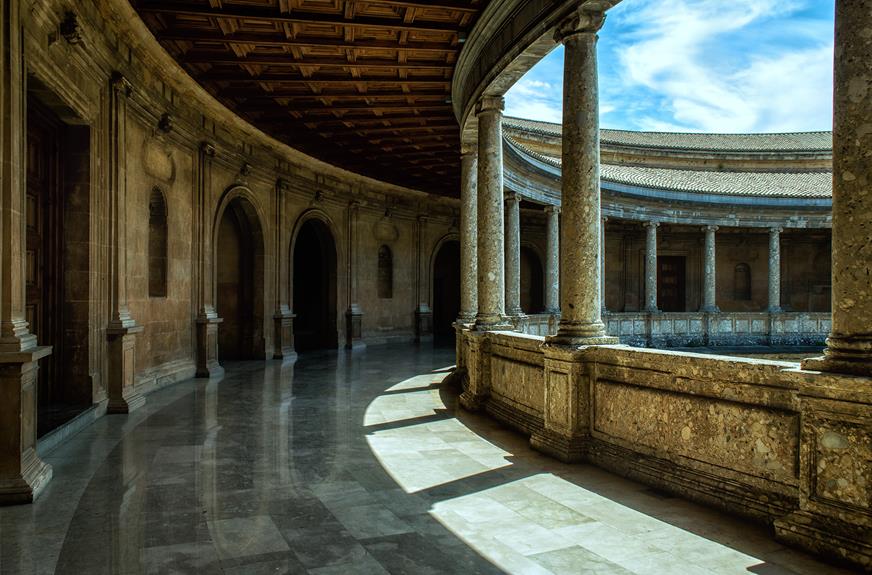
As a passionate traveler, I've always believed that history is the heartbeat of every destination. So when I set foot in Spain, I was enveloped in a mesmerizing tapestry of the past. From the awe-inspiring Roman ruins to the enchanting Moorish architecture in Andalusia, and the majestic medieval castles in Catalonia, this country is a treasure trove of historical wonders. Join me on a journey to uncover Spain's rich heritage, beyond the bustling cities of Barcelona and Madrid.
Key Takeaways
Table of Contents
- Spain is home to well-preserved Roman ruins, showcasing its ancient history.
- Andalusia's Moorish architecture, seen in landmarks like the Alhambra and Mezquita, is a testament to the grandeur and beauty of this style.
- Catalonia's medieval castles offer a captivating glimpse into medieval life, with their rich history and immersive festivals.
- Spain has numerous UNESCO World Heritage Sites, such as the Alhambra and Santiago de Compostela, that allow visitors to explore its diverse cultural heritage.
Roman Ruins in Spain
I discovered a plethora of well-preserved Roman ruins while exploring Spain. The country is a treasure trove of ancient history, and the Roman ruins are a testament to its rich past. As I ventured through Spain, I utilized various exploration techniques to uncover these remarkable archaeological sites. From following ancient maps to seeking local advice, I immersed myself in the world of the Romans. However, preserving these ruins posed significant challenges. The passage of time, exposure to the elements, and human interference threatened their integrity. Conservation efforts were implemented to protect these historical treasures. I marveled at the meticulous restoration work done to ensure that future generations can appreciate the grandeur and significance of these Roman ruins. Through exploration and preservation, Spain's Roman ruins continue to captivate and educate visitors.
Moorish Architecture in Andalusia
As I wandered through Andalusia, I marveled at the exquisite Moorish architecture that adorned the cities and towns. The Islamic influence on the region's architectural marvels was truly remarkable. Here are some highlights:
- The Alhambra: This majestic palace complex in Granada is a masterpiece of Moorish architecture. Its intricate carvings, vibrant tilework, and tranquil gardens leave visitors in awe.
- The Mezquita: Located in Cordoba, this former mosque is a testament to the grandeur of Moorish design. With its horseshoe arches, intricate mosaics, and imposing prayer hall, it is a true architectural gem.
- The Alcazar: Seville's Alcazar is a stunning palace that showcases a fusion of Moorish and Christian styles. Its intricate plasterwork, lush gardens, and tranquil courtyards make it a must-visit.
- The Giralda: This iconic bell tower in Seville was originally a minaret. Its unique blend of Moorish and Gothic elements is a testament to the region's rich history.
Exploring these architectural wonders allows visitors to truly appreciate the beauty and cultural significance of Moorish architecture in Andalusia.
Medieval Castles in Catalonia
Continuing my exploration of Spain's rich historical treasures, I was captivated by the medieval castles scattered throughout Catalonia. These majestic fortifications stand as a testament to the region's tumultuous past and offer a captivating glimpse into medieval life. From the towering walls of Montsoriu Castle to the grandeur of Cardona Castle, each structure tells a unique story of battles, power struggles, and resilience. These castles not only provide a stunning backdrop for breathtaking photos but also serve as venues for medieval festivals, where visitors can immerse themselves in the vibrant traditions of the past. The clang of swords, the sound of medieval music, and the colorful costumes transport you back in time, creating an unforgettable experience. Exploring Catalonia's medieval castles is like stepping into a living history book, where the past comes to life before your eyes.
UNESCO World Heritage Sites in Spain
One of the highlights of my journey through Spain's rich historical treasures is exploring the UNESCO World Heritage Sites scattered throughout the country. These sites not only showcase the country's diverse cultural heritage but also provide a glimpse into its fascinating history. Here are some of the must-visit UNESCO World Heritage Sites in Spain:
- The Alhambra: This stunning palace complex in Granada is a masterpiece of Islamic art, with its intricate geometric patterns, stunning arches, and beautiful gardens.
- Santiago de Compostela: Known for its famous pilgrimage routes, this city in Galicia is a spiritual hub for travelers from around the world. The Cathedral of Santiago de Compostela, the final destination of the Camino de Santiago, is a magnificent example of Romanesque architecture.
- Historic Center of Cordoba: This UNESCO site is home to the iconic Mezquita, a breathtaking mosque-turned-cathedral that showcases the coexistence of Islamic and Christian cultures.
- Palau de la Música Catalana and Hospital de Sant Pau: Located in Barcelona, these two architectural gems are prime examples of Catalan Modernism, with their ornate designs and intricate details.
Exploring these UNESCO World Heritage Sites in Spain is an unforgettable experience that allows you to immerse yourself in the country's rich history and cultural heritage.
Historic Spanish Cities: Beyond Barcelona and Madrid
I have explored many historic Spanish cities beyond Barcelona and Madrid, and each one has its unique charm and historical significance. While Barcelona and Madrid are undoubtedly popular destinations, there are hidden gems in Spain that are worth discovering. Lesser known historic towns such as Toledo, Segovia, and Salamanca offer a glimpse into Spain's rich past. Toledo, known as the "City of Three Cultures," showcases a blend of Christian, Muslim, and Jewish influences. Segovia captivates visitors with its stunning Roman aqueduct and medieval Alcázar fortress. Salamanca, home to one of the oldest universities in Europe, boasts exquisite Gothic and Renaissance architecture. Exploring these lesser known historic towns allows travelers to delve deeper into Spain's history and experience its cultural diversity beyond the bustling streets of Barcelona and Madrid.
Frequently Asked Questions
How Can I Book a Guided Tour of the Roman Ruins in Spain?
I can book a guided tour of the Roman ruins in Spain by contacting a local tour agency. They can provide information on the historical significance of the sites and arrange for a knowledgeable guide.
Are There Any Restrictions on Visiting the Moorish Architecture Sites in Andalusia?
There are no visiting restrictions on the Moorish architecture sites in Andalusia. Cultural preservation measures ensure their beauty is maintained for future generations. It's a captivating experience to explore these historical treasures.
What Are the Opening Hours of the Medieval Castles in Catalonia?
The opening hours of the medieval castles in Catalonia vary. Some castles may have restricted hours due to ongoing restoration projects. However, popular medieval castles like Montjuïc Castle and Cardona Castle are usually open to visitors during regular hours.
Can You Recommend Any UNESCO World Heritage Sites in Spain That Are off the Beaten Path?
Sure, I can recommend some off the beaten path UNESCO World Heritage Sites in Spain. Exploring lesser known hidden gems of Spanish history is a fascinating way to discover the country's rich cultural heritage.
What Are Some Historic Spanish Cities Worth Exploring Outside of Barcelona and Madrid?
I highly recommend exploring Seville and Granada in Spain. These historic cities offer a rich cultural experience with their beautiful architecture, fascinating history, and vibrant atmosphere.




Leave a Reply
You must be logged in to post a comment.